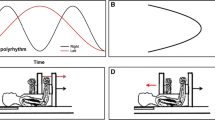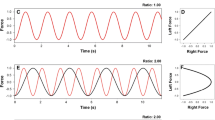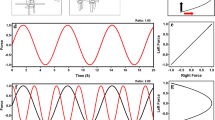Abstract
Three experiments were designed to determine the level of cooperation or interference observed from the forces generated in one limb on the forces exhibited by the contralateral limb when one or both limbs were producing a constant force (Experiment 1), one limb was producing a dynamic force while the other limb was producing a constant force (Experiment 2), and both limbs were producing dynamic force patterns (Experiment 3). The results for both Experiments 1 and 2 showed relatively strong positive time series cross correlations between the left and right limb forces indicating increases or decreases in the forces generated by one limb resulted in corresponding changes in the forces produced by the homologous muscles of the contralateral limb. Experiment 3 required participants to coordinate 1:1 and 1:2 rhythmical bimanual force production tasks when provided Lissajous feedback. The results indicated very effective performance of both bimanual coordination patterns. However, identifiable influences of right limb forces on the left limb force time series were observed in the 1:2 coordination pattern but not in the 1:1 pattern. The results of all three experiments support the notion that neural crosstalk is partially responsible for the stabilities and instabilities associated with bimanual coordination.






Similar content being viewed by others
References
Aramaki, Y., Honda, M., Okada, T., & Sadato, N. (2006). Neural correlates of the spontaneous phase transition during bimanual coordination. Cerebral Cortex, 16, 1338–1348.
Aramaki, Y., Osu, R., & Sadato, N. (2010). Resource-demanding versus cost-effective bimanual interaction in the brain. Experimental Brain Research, 203, 407–418.
Armatas, C. A., & Summers, J. J. (2001). The influence of task characteristics on the intermanual asymmetry of motor overflow. Journal of Clinical Experimental Neuropsycholology, 23, 557–567.
Armatas, C. A., Summers, J. J., & Bradshaw, J. L. (1996). Handedness and performance variability as factors influencing mirror movement occurrence. Journal of Clinical Experimental Neuropsychology, 18, 823–835.
Barral, J., De Pretto, M., Debû, B., & Hauert, C. A. (2010). Activation and inhibition of bimanual movements in school-aged children. Human Physiology, 36, 47–57.
Barral, J., Debû, B., & Rival, C. (2006). Developmental changes in unimanual and bimanual aiming movements. Developmental Neuropsycholgy, 29, 415–429.
Beets, I. A. M, Gooijers, J., Boisgontier, M. P., Pauwels, L., Coxon, J. P., Wittenberg, G., & Swinnen, S. P. (2014). Reduced neural differentiation between feedback conditions after bimanual coordination with and without augmented feedback. Cerebral Cortex. doi:10.1093/cercor/bhu005
Boyles, J., Panzer, S., & Shea, C. H. (2012). Increasingly complex bimanual multi-frequency coordination patterns are equally easy to perform with on-line relative velocity feedback. Experimental Brain Research, 216, 515–525.
Buchanan, J. J., Park, J. H., & Shea, C. H. (2006). Target width scaling in a repetitive aiming task: switching between cyclical and discrete units of action. Experimental Brain Research, 175, 710–725.
Buchanan, J. J., & Ryu, Y. U. (2012). Scaling movement amplitude: adaptation of timing and amplitude control in a bimanual task. Journal of Motor Behavior, 44, 135–147.
Byblow, W. D., Bysouth-Young, D., Summers, J. J., & Carson, R. G. (1998). Performance asymmetries and coupling dynamics in the acquisition of multifrequency bimanual coordination. Psychologoical Research, 61, 56–70.
Byblow, W. D., & Goodman, D. (1994). Performance asymmetries in multifrequency coordination. Human Movement Science, 13, 147–174.
Cardoso de Oliveira, S. (2002). The neuronal basis of bimanual coordination: recent neurophysiological evidence and functional models. Acta Psychologica, 110, 139–159.
Carson, R. G., Byblow, W. D., Abernethy, B., & Summers, J. J. (1996). The contribution of inherent and incidental constraints to intentional switching between patterns of bimanual coordination. Human Movement Science, 15, 565–589.
Carson, R. G., Riek, C. J., Smethurst, J. F., Lison Parraga, J. F., & Byblow, W. D. (2000). Neuromuscular-skeletal constraints upon the dynamics of unimanual and bimanual coordination. Experimental Brain Research, 131, 196–214.
Cattaert, D., Semjen, A., & Summers, J. J. (1999). Simulating a neural cross-talk model for between-hand interference during bimanual circle drawing. Biological Cybernetics, 81, 343–358.
Cincotta, M., Giovannelli, F., Borgheresi, A., Balestrieri, F., Vanni, P., Ragazzoni, A., & Ziemann, U. (2006). Surface electromyography shows increased mirroring in Parkinson’s disease patients without overt mirror movements. Movement Disorders, 21, 1461–1465.
Cohen, L. (1971). Synchronous bimanual movements performed by homologous and non-homologous muscles. Perceptual Motor Skills, 32, 639–644.
Deutsch, D. (1983). The generation of two isochronous sequences in parallel. Perception and Psychophysics, 34, 331–337.
Diedrichsen, J., Hazeltine, E., Nurss, W. K., & Ivry, R. B. (2003). The role of the corpus callosum in the coupling of bimanual isometric force pulses. Journal of Neurophysiology, 4, 2409–2418.
Franz, E. A., Eliassen, J. C., Ivry, R. B., & Gazzaniga, M. S. (1996). Dissociation of spatial and temporal coupling in the bimanual movements of callosotomy patients. Psychological Science, 7, 306–310.
Guiard, Y. (1987). Asymmetric division of labor in human skilled bimanual action: the kinematic chain as a model. Journal of Motor Behavior, 19, 486–517.
Guiard, Y. (1993). On Fitts’s and Hooke’s laws: simple harmonic movement in upper-limb cyclical aiming. Acta Psychologica, 82, 139–159.
Guiard, Y. (1997). Fitts’ law in the discrete vs cyclical paradigm. Human Movement Science, 16, 97–131.
Hessler, E. E., Gonzales, L. M., & Amazeen, P. G. (2010). Displays that facilitate performance of multifrequency ratios during motor-respiratory coordination. Acta Psychologica, 133, 96–105.
Heuer, H., Kleinsorge, T., Spijkers, W., & Steglich, W. (2001). Static and pha-sic cross-talk effects in discrete bimanual reversal movements. Journal of Motor Behavior, 33, 67–85.
Heuer, H., Spijkers, W., Steglich, C., & Kleinsorge, T. (2002). Parametric coupling and generalized decoupling revealed by concurrent and successive isometric contractions of distal muscles. Acta Psychologica, 111, 205–242.
Hill, A. V. (1970). First and last experiments in muscle mechanics. Cambridge: Cambridge University Press.
Houweling, S., Beek, P. J., & Daffertshofer, A. (2010). Spectral changes of interhemispheric crosstalk during movement instabilities. Cerebral Cortex, 20, 2605–2613.
Hu, X., Loncharich, M., & Newell, K. M. (2011). Visual information interacts with neuromuscular factors in the coordination bimanual isometric force. Experimental Brain Research, 209, 129–138.
Hu, X., & Newell, K. M. (2011a). Adaption to bimanual asymmetric weights in isometric force coordination. Neuroscience Letters, 490, 121–125.
Hu, X., & Newell, K. M. (2011b). Visual information gain and task asymmetry interact in bimanual force coordination and control. Experimental Brain Research, 212, 497–504.
Kagerer, F. A., Summers, J. J., & Semjen, A. (2003). Instabilities during antiphase bimanual movements: are ipsilateral pathways involved? Experimental Brain Research, 151, 489–500.
Kasuga, S., & Nozaki, D. (2011). Cross talk in implicit assignment of error information during bimanual visuomotor learning. Journal of Neurophysiology, 106, 1218–1226.
Kelso, J. A. S. (1995). Dynamic patterns: the self-organization of the brain and behavior. Cambridge: MIT Press.
Kelso, J. A. S., Scholz, J. P., & Schoner, G. (1986). Nonequilibrium phase-transitions in coordinated biological motion; critical fluctuations. Physics Letters A, 118, 279–284.
Kennedy, D. M., Boyle, J. B., Rhee, J., & Shea, C. H. (2014). Rhythmical bimanual force production: homologous and non-homologous muscles. Experimental Brain Research. doi:10.1007/s00221-014-4102-y
Kennedy, D. M., Wang, C., & Shea, C. H. (2013). Reacting while moving: influence of right limb movement on left limb reaction. Experimental Brain Research, 230, 143–152.
Kovacs, A. J., Buchanan, J. J., & Shea, C. H. (2009). Bimanual 1:1 with 90 degrees continuous relative phase: difficult or easy. Experimental Brain Research, 193, 129–136.
Kovacs, A. J., Buchanan, J. J., & Shea, C. H. (2010a). Impossible is nothing: 5:3 and 4:3 multi-frequency bimanual coordination. Experimental Brain Research, 201, 249–259.
Kovacs, A. J., Buchanan, J. J., & Shea, C. H. (2010b). Perceptual and attentional influences on continuous 2:1 and 3:2 multi-frequency bimanual coordination. Journal of Experimental Psychology: Human Perception and Performance, 36, 936–954.
Kovacs, A. J., & Shea, C. H. (2010). Amplitude differences, spatial assimilation, and integrated feedback in bimanual coordination. Experimental Brain Research, 202, 519–525.
Kovacs, A. J., & Shea, C. H. (2011). The learning of 90 degrees continuous relative phase with and without Lissajous feedback: external and internally generated bimanual coordination. Acta Psychologica, 136, 311–320.
Krishnan, V., & Jaric, S. (2010). Effects of task complexity on coordination of inter-limb and within-limb forces in static bimanual manipulation. Motor Control, 230, 528–544.
Latash, M. L. (2010). Motor synergies and the equilibrium-point hypothesis. Motor Control, 14, 294–322.
Latash, M. L. (2012). The bliss (not the problem) of motor abundance (not redundancy). Experimental Brain Research, 217, 1–5.
Levin, O., Suy, E., Huybrechts, J., Vangheluwe, S., & Swinnen, S. P. (2004). Bimanual coordination involving homologous and heterologous joint combinations: when lower stability is associated with higher flexibility. Behavioral Brain Research, 152, 437–445.
Maki, Y., Wong, K. F. K., Sugiura, M., Ozaki, T., & Sadato, N. (2008). Asymmetric control mechanisms of bimanual coordination: an application of directed connectivity analysis to kinematic and functional MRI data. Neuroimage, 42, 1295–1304.
Marteniuk, R. G., MacKenzie, C. L., & Baba, D. M. (1984). Bimanual movement control: information processing and interaction effects. Quarterly Journal of Experimental Psychology, 37, 335–365.
Monno, A., Chardenon, A., Temprado, J. J., Zanone, P. G., & Laurent, M. (2000). Effects of attention on phase transitions between bimanual coordination patterns: a behavioral and cost analysis in humans. Neuroscience Letters, 283, 93–96.
Murian, A., Deschamps, T., & Temprado, J. J. (2008). Effects of force production and trial duration on bimanual performance and attentional demands in a rhythmic coordination task. Motor Control, 12, 21–37.
Park, S., Dijkstra, T. M. H., & Sternad, D. (2013). Learning to never forget—time scales and specificity of long-term memory of a motor skill. Frontiers in Computational Neuroscience, 7, 1–13.
Peper, C. E., Beek, P. J., & van Wieringen, P. C. W. (1995a). Coupling strength in tapping a 2/3 polyrhythm. Human Movement Science, 14, 217–245.
Peper, C. E., Beek, P. J., & van Wieringen, P. C. W. (1995b). Frequency-induced phase-transitions in bimanual tapping. Biological Cybernetics, 73, 301–309.
Peper, C. E., Beek, P. J., & Vanwieringen, P. C. W. (1995c). Multifrequency coordination in bimanual tapping—asymmetrical coupling and signs of supercriticality. Journal of Experimental Psychology-Human Perception and Performance, 21, 1117–1138.
Puttemans, V., Wenderoth, N., & Swinnen, S. P. (2005). Changes in brain activation during the acquisition of a multifrequency bimanual coordination task: from the cognitive stage to advanced levels of automaticity. The Journal of Neuroscience, 25, 4270–4278.
Ridderikhoff, A., Peper, C. L., & Beek, P. J. (2005). Unraveling interlimb interactions underlying bimanual coordination. Journal Neurophysiology, 94, 3112–3125.
Riek, S., Carson, R. G., & Byblow, W. D. (1992). Spatial and muscular dependencies in bimanual coordination. Journal of Human Movement Studies, 23, 251–265.
Sainburg, R. L. (2010). Lateralization of goal-directed movement. Vision and goal-directed movement (pp. 219–288). Champaign: Human Kinetics.
Scholz, J. P., & Kelso, J. A. S. (1989). A quantitative approach to understanding the formation and change of coordinated movement patterns. Journal of Motor Behavior, 21, 122–144.
Semjen, A., & Summers, J. J. (2002). Timing goals in bimanual coordination. Quarterly Journal of Experimental Psychology A, Human Experimental Psychology, 55, 155–171.
Semjen, A., Summers, J. J., & Cattaert, D. (1995). Hand coordination in bimanual circle drawing. Journal of Experimental Psychology-Human Perception and Performance, 21, 1139–1157.
Serrien, D. (2009). Interactions between new and pre-existing dynamics in bimanual movement control. Experimental Brain Research, 197, 269–278.
Serrien, D., & Swinnen, S. P. (1997). Coordination constraints induced by effector combination under isofrequency and multifrequency conditions. Journal of Experimental Psychology-Human Perception and Performance, 23, 1493–1510.
Shapkova, E. Y., Shapkova, A. L., Goodman, S. R., Zatsiorsky, V. M., & Latash, M. L. (2008). Do synergies decrease force variability? A study of single-finger and multi-finger force production. Experimental Brain Research, 188, 411–425.
Sherwood, D. E. (1994). Hand preference, practice order, and spatial assimilations in rapid bimanual movements. Journal of Motor Behavior, 26, 123–134.
Sisti, H. M., Geurts, M., Clerckx, R., Gooijers, J., Coxon, J. P., Heitger, M. H., & Swinnen, S. P. (2011). Testing multiple coordination constraints with a novel bimanual visuomotor task. PLoS ONE, 6, e23619.
Spijkers, W., & Heuer, H. (1995). Structural constraints on the performance of symmetrical bimanual movements with different amplitudes. Quarterly Journal of Experimental Psychology Section a-Human Experimental Psychology, 48, 716–740.
Steglich, C., Heuer, H., Spijkers, W., & Kleinsorge, T. (1999). Bimanual coupling during the specification of isometric forces. Experimental Brain Research, 129, 302–316.
Sternad, D., Turvey, M. T., & Saltzman, E. L. (1999a). Dynamics of 1:2 coordination: temporal scaling, latent 1:1, and bistability. Journal of Motor Behavior, 31, 236–247.
Sternad, D., Turvey, M. T., & Saltzman, E. L. (1999b). Dynamics of 1:2 coordination: sources of symmetry breaking. Journal of Motor Behavior, 31, 224–235.
Sternad, D., Turvey, M. T., & Saltzman, E. L. (1999c). Dynamics of 1:2 coordination: generalizing relative phase to n:m rhythms. Journal of Motor Behavior, 31, 207–223.
Stone, K. D., Bryant, D. C., & Gonzalez, C. L. R. (2013). Hand use for grasping in a bimanual task: evidence for different roles? Experimental Brain Research, 224, 455–467.
Summers, J. J., Davis, A. S., & Byblow, W. D. (2002). The acquisition of bimanual coordination is mediated by anisotropic coupling between the hands. Human Movement Science, 21, 699–721.
Summers, J. J., Maeder, S., Hiraga, C. Y., & Alexander, J. R. (2008). Coordination dynamics and attentional costs of continuous and discontinuous bimanual circle drawing movements. Human Movement Science, 27, 823–837.
Summers, J. J., Todd, J. A., & Kim, Y. H. (1993). The influence of perceptual and motor factors on bimanual coordination in a polyrhythmic tapping task. Psychological Research, 55, 107–115.
Swinnen, S. P. (2002). Intermanual coordination: from behavioural principles to neural-network interactions. Nature Review: Neuroscience, 3, 348–359.
Swinnen, S. P., Dounskaia, N., & Duysens, J. (2002). Patterns of bimanual interference reveal movement encoding within a radial egocentric reference frame. Journal of Cognitive Neuroscience, 14, 463–471.
Swinnen, S. P., Dounskaia, N., Levin, O., & Duysens, J. (2001). Constraints during bimanual coordination: the role of direction in relation to amplitude and force requirements. Behavioral Brain Research, 123, 201–218.
Swinnen, S. P., Dounskaia, N., Walter, C. B., & Serrien, D. J. (1997). Preferred and induced coordination modes during the acquisition of bimanual movements with a 2:1 frequency ratio. Journal of Experimental Psychology: Human Perception and Performance, 23, 1087–1110.
Swinnen, S. P., & Wenderoth, N. (2004). Two hands, one brain: cognitive neuroscience of bimanual skill. Trends in Cognitive Sciences, 8, 18–25.
Temprado, J. J., Chardenon, A., & Laurent, M. (2001). Interplay of biomechanical and neuromuscular constraints on pattern stability and attentional demands in a bimanual coordination task in human subjects. Neuroscience Letters, 303, 127–131.
Temprado, J. J., Zanone, P. G., Monno, A., & Laurent, M. (1999). Attentional load associated with performing and stabilizing preferred bimanual patterns. Journal of Experimental Psychology: Human Perception and Performance, 25, 1579–1594.
Therrien, A. S., Lyons, J., & Balasubramaniam, R. (2013). Continuous theta-burst stimulation to primary motor cortex reveals asymmetric compensation for sensory attenuation in bimanual repetitive force production. Journal of Neurophysiology, 110, 872–882.
Treffner, P. J., & Turvey, M. T. (1993). Resonance constraints on rhythmic movement. Journal of Experimental Psychology: Human Perception and Performance, 19, 1221–1237.
Uttner, I., Kraft, E., Nowak, D. A., Muller, F., Philipp, J., Zierdt, A., & Hermsdorfer, J. (2007). Mirror movements and the role of handedness: isometric grip forces changes. Motor Control, 11, 16–28.
Zanone, P. G., & Kelso, J. A. S. (1992). The evolution of behavioral attractors with learning: nonequilibrium phase transitions. Journal of Experimental Psychology: Human Perception and Performance, 18, 403–421.
Acknowledgments
This work was supported by student research grants from the Huffines Institute and College of Education and Human Development, Texas A&M University to D. M. Kennedy.
Author information
Authors and Affiliations
Corresponding author
Rights and permissions
About this article
Cite this article
Kennedy, D.M., Boyle, J.B., Wang, C. et al. Bimanual force control: cooperation and interference?. Psychological Research 80, 34–54 (2016). https://doi.org/10.1007/s00426-014-0637-6
Received:
Accepted:
Published:
Issue Date:
DOI: https://doi.org/10.1007/s00426-014-0637-6




